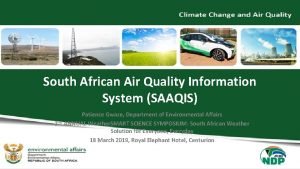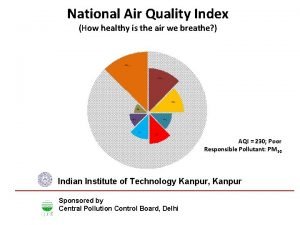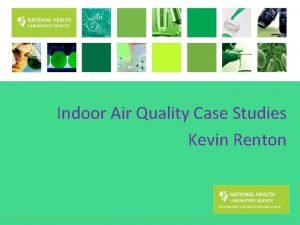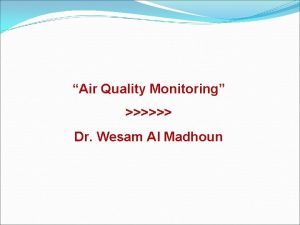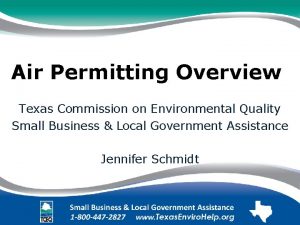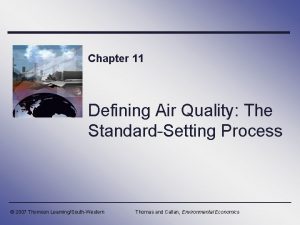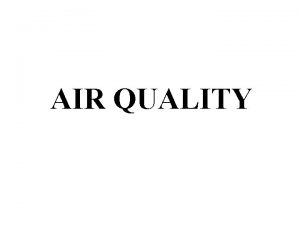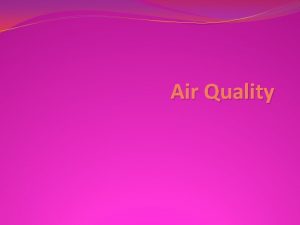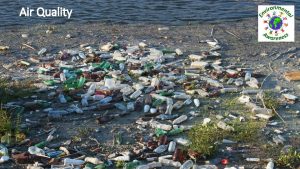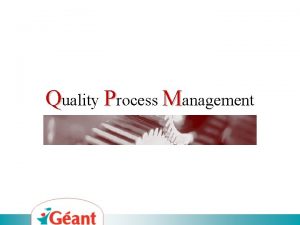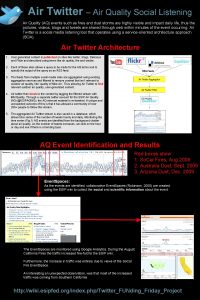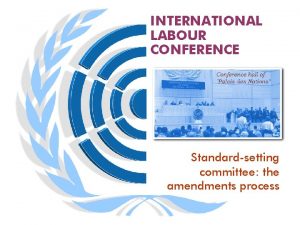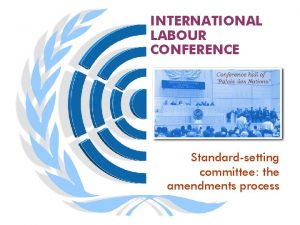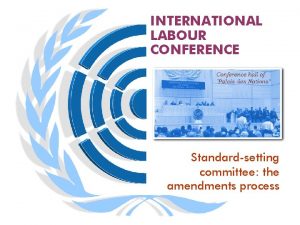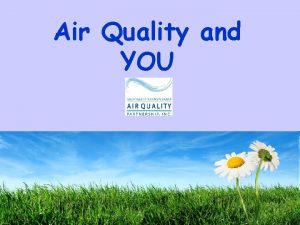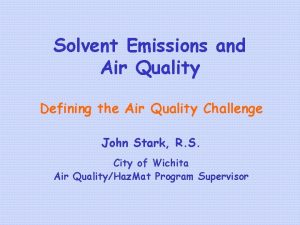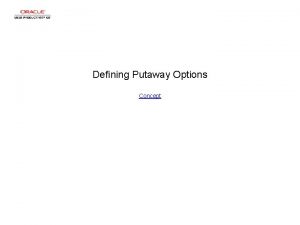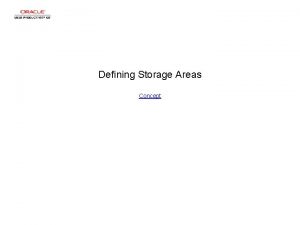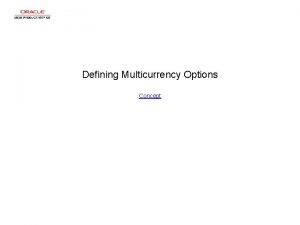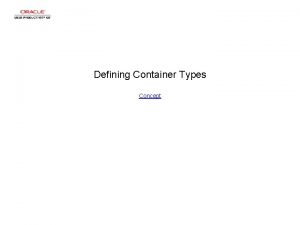Chapter 10 Defining Air Quality The StandardSetting Process























- Slides: 23

Chapter 10 Defining Air Quality: The Standard-Setting Process © 2004 Thomson Learning/South-Western

Defining Air Quality: The Standard. Setting Process Natural pollutants – contaminates that come about through nonartificial processes in nature l Anthropogenic pollutants – contaminants associated with human activity including, polluting residuals from consumption and production l 2

Overview of Air Quality Legislation in the United States l In the Beginning ¡ ¡ No national air quality laws until the Air Pollution Control Act of 1955 No truly comprehensive legislation until Clean Air Act of 1963 3

Overview of Air Quality Legislation in the United States l Current U. S. Policy ¡ 1990 Clean Air Act Amendments use some marketbased approaches, but underlying structure continues to be command-control oriented 4

Defining the Objectives of Air Quality Control l Identifying Major Air Pollutants ¡ ¡ ¡ Criteria documents – reports that present scientific evidence on the properties and effects of known or suspected pollutants Criteria pollutants – substances known to be hazardous to health and welfare, characterized as harmful by criteria documents Hazardous air pollutants – noncriteria pollutants that may cause or contribute to irreversible illness or increased mortality 5

Setting Standards As a National Definition of Air Quality Stationary source – a fixed-site producer of pollution, such as a building or manufacturing plant l Mobile source – any nonstationary polluting source, including all transport vehicles l 6

Setting Standards As a National Definition of Air Quality l Standards for Criteria Air Pollutants ¡ ¡ ¡ National ambient air quality standards (NAAQS) – maximum allowable concentrations of criteria air pollutants Primary NAAQS – set to protect public health from air pollution, with some margin of safety Secondary NAAQS – Set to protect public welfare from any adverse, nonhealth effects of air pollution 7

Setting Standards As a National Definition of Air Quality l Standards for Hazardous Air Pollutants ¡ ¡ National Emission Standards for Hazardous Air Pollutants (NESHAP) – set to protect public health and the environment applicable to every major source of any identified hazardous air pollutant Maximum Achievable Control Technology (MACT) – the control technology that achieves the degree of reduction to be accomplished by the NESHAP 8

Establishing an Infrastructure To Implement the Standards l State Implementation Plans ¡ l State Implementation Plan (SIP) – a procedure outlining how a state intends to implement, monitor, and enforce the NAAQS and the NESHAP Air Quality Control Regions ¡ Air Quality Control Regions (AQCR) – a geographic area designated by the federal government within which common air pollution problems are shared by several communities 9

Establishing an Infrastructure To Implement the Standards l Reclassification of AQCRs To Protect “Clean Air Areas” ¡ ¡ Prevention of significant deterioration (PSD) area – an AQCR meeting or exceeding the NAAQS Nonattainment area – an AQCR not in compliance with the NAAQS 10

Establishing an Infrastructure To Implement the Standards l 1990 Reclassification of Nonattainment Areas by Criteria Pollutant ¡ ¡ ¡ Monitoring Air Quality Across Regions Estimating pollutant emissions levels l Not feasible to measure actual pollutant emissions levels on a national scale, so instead they are estimated Measuring pollutant concentrations l Measured at air-monitoring station sites located throughout the country 11

Establishing an Infrastructure To Implement the Standards Figure 10. 1 Summary of Changes in U. S. Emissions of Criteria Pollutants, 1970 – 2000 12

Economic Analysis of U. S. Air Quality Policy has become more comprehensive over time l By systematically estimating and evaluating the cots and benefits associated with the Clean Air Act, one can determine whether the U. S. air control policy is allocatively efficient l ¡ Maximization of net benefits – the point where the associated marginal social costs and marginal social benefits are equal 13

Benefit-Cost Analysis of the Clean Air Act l Benefit-Cost Analysis of the Pre-1990 Clean Air Act ¡ ¡ ¡ Total social costs Total social benefits Benefit-cost comparison 14

Benefit-Cost Analysis of the Clean Air Act Figure 10. 2 Benefit-Cost Analysis of U. S. Air Quality Controls as of 1981 15

Benefit-Cost Analysis of the Clean Air Act l Benefit-Cost Analysis to the 1990 Amendments ¡ ¡ Marginal Costs and Benefits Benefit-Cost Comparison 16

Benefit-Cost Analysis of the Clean Air Act Figure 10. 3 Analyzing the Marginal and Total Social Costs and Social Benefits Associated with the 1990 Clean Air Act Amendments 17

Benefit-Cost Analysis of the Clean Air Act l EPA’s Benefit-Cost Analysis of the 1990 Amendments ¡ EPA’s quantitative results, though recognized as based on sound methods and data, are considered to be controversial on a number of fronts 18

Benefit-Cost Analysis of the Air Quality Standards l Absence of Cost Considerations in the Standard-Setting Process ¡ ¡ Setting the National Ambient Air Quality Standards (NAAQS) Setting the national emission standards for hazardous air pollutants (NESHAP) l Benefit-based decision rule – a guideline to improve society’s well-being with no allowance for a balancing of the associated costs 19

Benefit-Cost Analysis of the Air Quality Standards l Uniformity of the National Ambient Air Quality Standards (NAAQS) ¡ ¡ ¡ Since nationally based, NAAQS ignores any regionspecific cost or benefit differences associated with meeting them Benefit-Cost Analysis of Higher PSD Standards l Use of relatively higher standards for PSD areas can be efficient, but only under certain conditions Benefit-Cost Analysis of Progressively Regulated Nonattainment Areas 20

Benefit-Cost Analysis of the Air Quality Standards Figure 10. 4(a) Economic Modeling of Higher Air Quality Standards in PSD Areas Relative to Nonattainment Areas 21

Benefit-Cost Analysis of the Air Quality Standards Figure 10. 4(b) Economic Modeling of Higher Air Quality Standards in PSD Areas Relative to Nonattainment Areas 22

Benefit-Cost Analysis of the Air Quality Standards Figure 10. 4(c) Economic Modeling of Higher Air Quality Standards in PSD Areas Relative to Nonattainment Areas 23
 Defining/non-defining relative clauses
Defining/non-defining relative clauses Relative clauses defining and non defining
Relative clauses defining and non defining Defining and non defining relative clauses
Defining and non defining relative clauses Defining relative clause meaning in telugu
Defining relative clause meaning in telugu Non defining relative clauses
Non defining relative clauses Non defining relatives clauses
Non defining relatives clauses Air higroskopis adalah
Air higroskopis adalah Chapter 12 section 1 what causes air pollution answers
Chapter 12 section 1 what causes air pollution answers Chapter 12 air section 1 what causes air pollution
Chapter 12 air section 1 what causes air pollution Quality assurance vs quality control
Quality assurance vs quality control Quality control vs quality assurance pmp
Quality control vs quality assurance pmp Quality metrics pmp
Quality metrics pmp Quality assurance cycle in nursing
Quality assurance cycle in nursing Compliance vs quality
Compliance vs quality Basic concept of quality control and quality assurance pdf
Basic concept of quality control and quality assurance pdf David a garvin 8 dimensions of quality
David a garvin 8 dimensions of quality Quality is free
Quality is free Old quality vs new quality
Old quality vs new quality Saaqis
Saaqis Air quality index calculation
Air quality index calculation Air quality renton
Air quality renton Ambient air quality standards
Ambient air quality standards St louis air quality
St louis air quality Tceq de minimis list
Tceq de minimis list


















